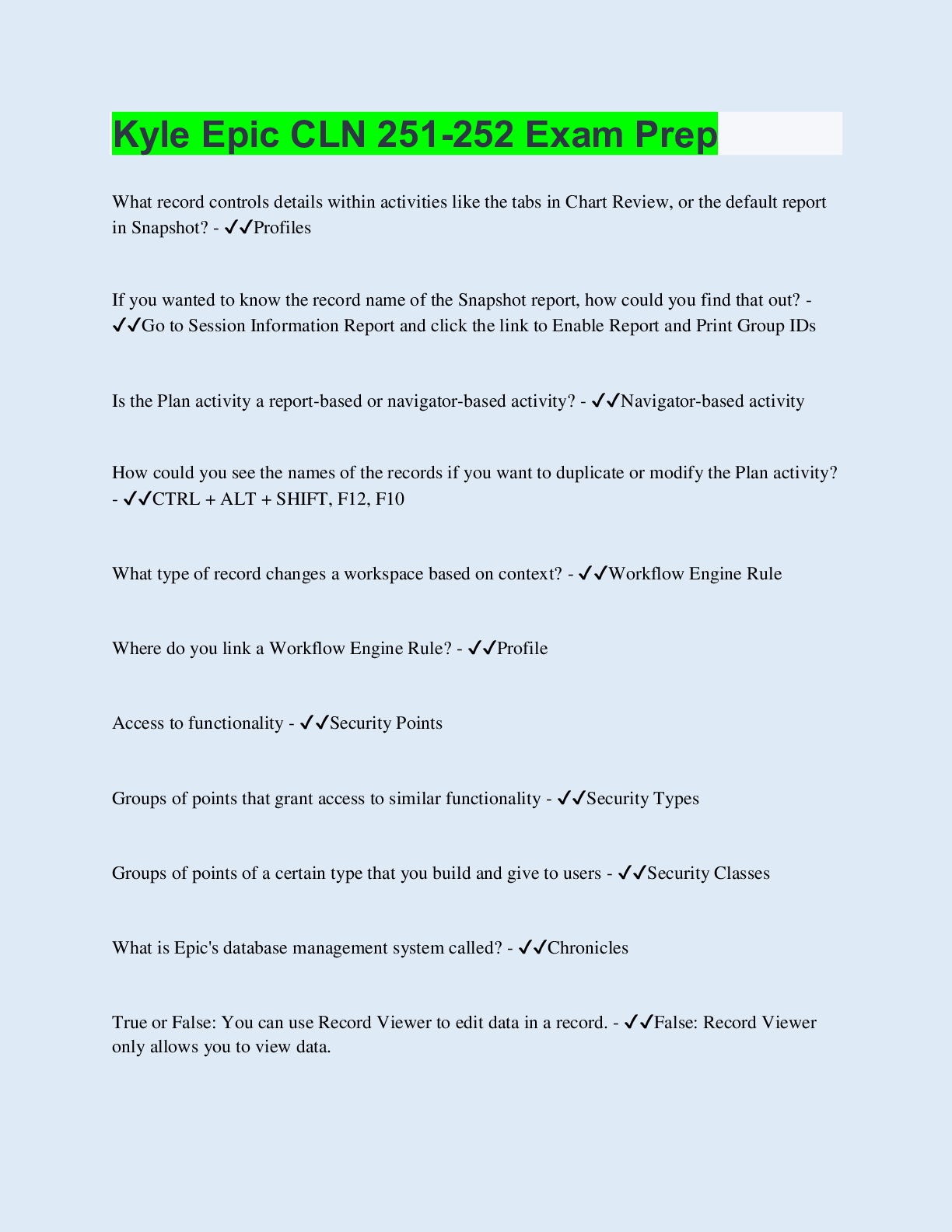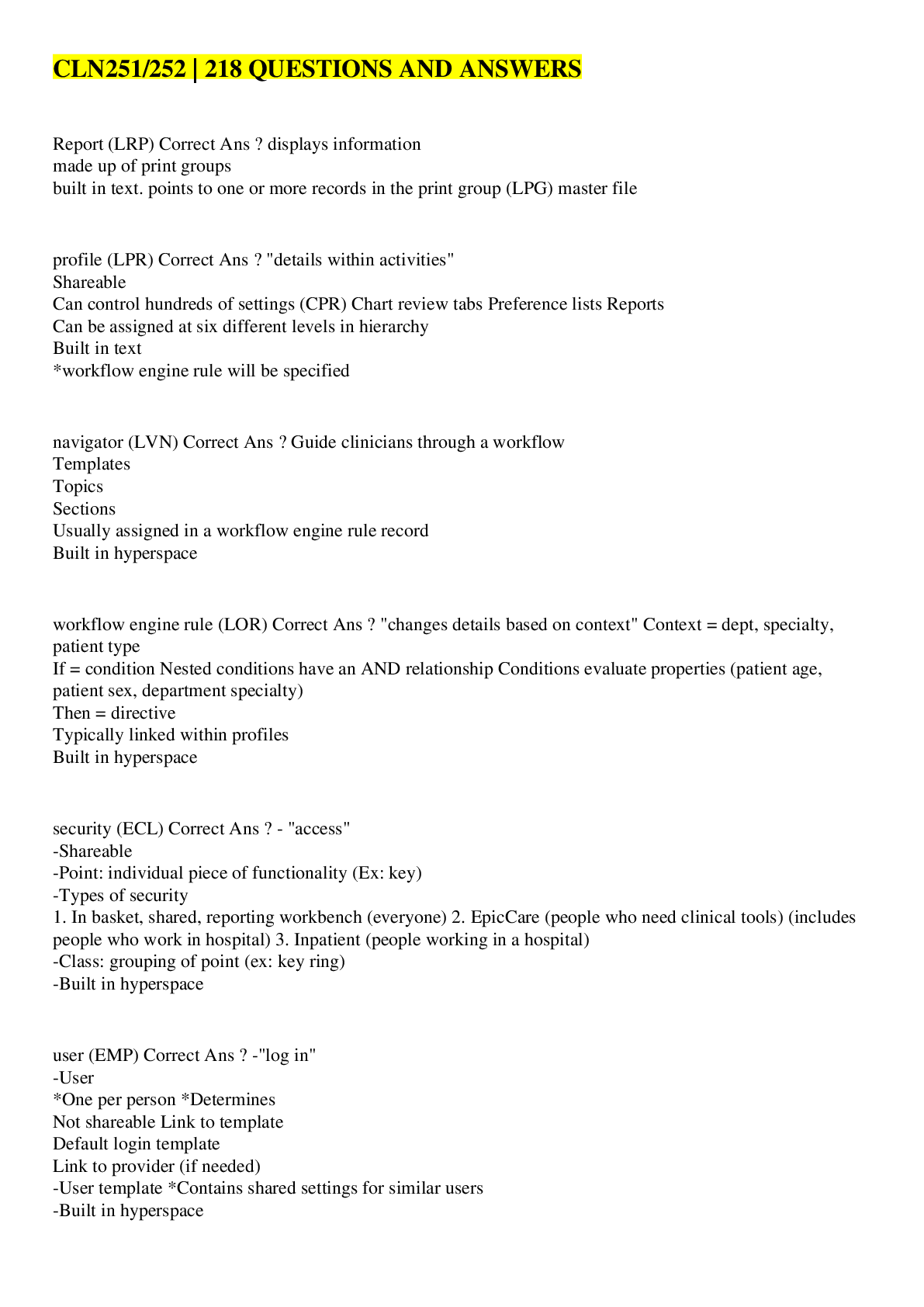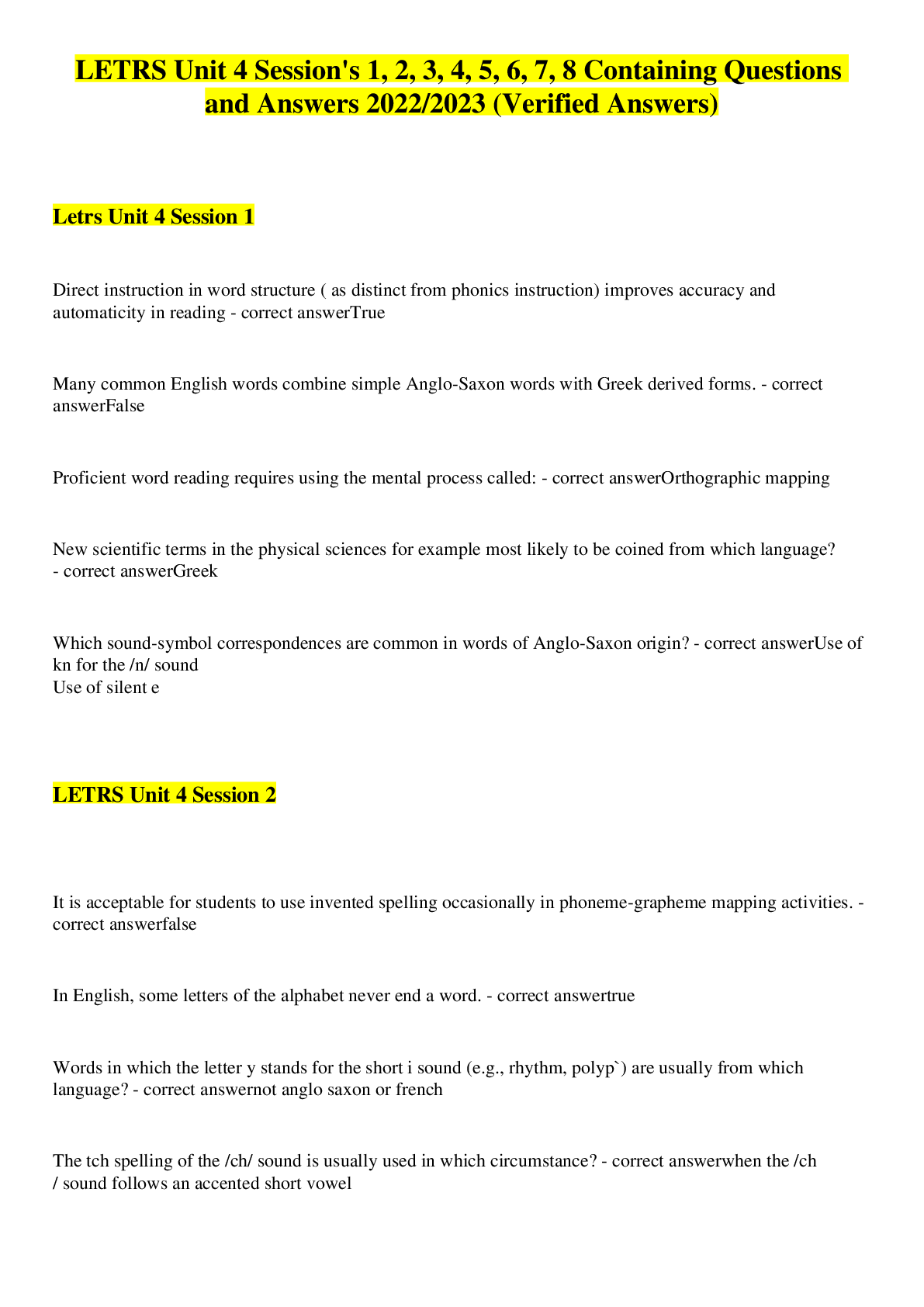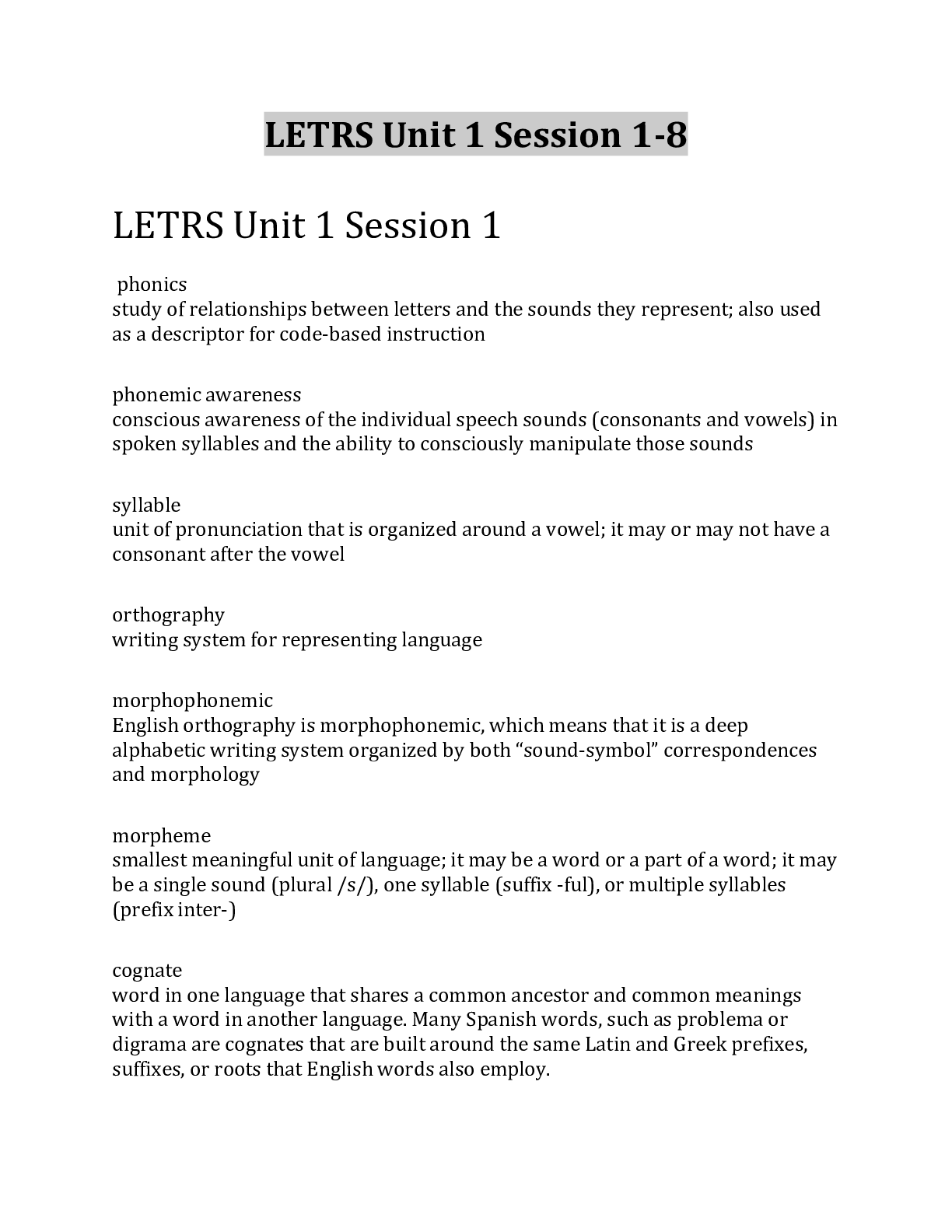Health Care > EXAM > Med Surg II Renal Exam Questions and Answers (All)
Med Surg II Renal Exam Questions and Answers
Document Content and Description Below
Med Surg II Renal Exam Questions and Answers.Chapter 65: Assessment of the Renal/Urinary System Chapter 65: Assessment of the Renal/Urinary System Ignatavicius: Medical-Surgical Nursing, 8th Edi... tion MULTIPLE CHOICE 1. A nurse reviews the urinalysis of a client and notes the presence of glucose. Which action should the nurse take? a. Document findings and continue to monitor the client. b. Contact the provider and recommend a 24-hour urine test. c. Review the client’s recent dietary selections. d. Perform a capillary artery glucose assessment. ANS: D Glucose normally is not found in the urine. The normal renal threshold for glucose is about 220 mg/dL, which means that a person whose blood glucose is less than 220 mg/dL will not have glucose in the urine. A positive finding for glucose on urinalysis indicates high blood sugar. The most appropriate action would be to perform a capillary artery glucose assessment. The client needs further evaluation for this abnormal result; therefore, documenting and continuing to monitor is not appropriate. Requesting a 24-hour urine test or reviewing the client’s dietary selections will not assist the nurse to make a clinical decision related to this abnormality. 2. A nurse reviews the health history of a client with an oversecretion of renin. Which disorder should the nurse correlate with this assessment finding? a. Alzheimer’s disease b. Hypertension c. Diabetes mellitus d. Viral hepatitis ANS: B Renin is secreted when special cells in the distal convoluted tubule, called the macula densa, sense changes in blood volume and pressure. When the macula densa cells sense that blood volume, blood pressure, or blood sodium levels are low, renin is secreted. Renin then converts angiotensinogen into angiotensin I. This leads to a series of reactions that cause secretion of the hormone aldosterone. This hormone increases kidney reabsorption of sodium and water, increasing blood pressure, blood volume, and blood sodium levels. Inappropriate or excessive renin secretion is a major cause of persistent hypertension. Renin has no impact on Alzheimer’s disease, diabetes mellitus, or viral hepatitis. 3. A nurse reviews the urinalysis results of a client and notes a urine osmolality of 1200 mOsm/L. Which action should the nurse take? a. Contact the provider and recommend a low-sodium diet. b. Prepare to administer an intravenous diuretic. c. Obtain a suction device and implement seizure precautions. d. Encourage the client to drink more fluids. ANS: D Normal urine osmolality ranges from 300 to 900 mOsm/L. This client’s urine is more concentrated, indicating dehydration. The nurse should encourage the client to drink more water. Dehydration can be associated with elevated serum sodium levels. Although a low-sodium diet may be appropriate for this client, this diet change will not have a significant impact on urine osmolality. A diuretic would increase urine output and decrease urine osmolality further. Low serum sodium levels, not elevated serum levels, place the client at risk for seizure activity. These options would further contribute to the client’s dehydration or elevate the osmolality. 4. A nurse assesses a client with renal insufficiency and a low red blood cell count. The client asks, “Is my anemia related to the renal insufficiency?” How should the nurse respond? a. “Red blood cells produce erythropoietin, which increases blood flow to the kidneys.” b. “Your anemia and renal insufficiency are related to inadequate vitamin D and a loss of bone density.” c. “Erythropoietin is usually released from the kidneys and stimulates red blood cell production in the bone marrow.” d. “Kidney insufficiency inhibits active transportation of red blood cells throughout the blood.” ANS: C Erythropoietin is produced in the kidney and is released in response to decreased oxygen tension in the renal blood supply. Erythropoietin stimulates red blood cell production in the bone marrow. Anemia and renal insufficiency are not manifestations of vitamin D deficiency. The kidneys do not play a role in the transportation of red blood cells or any other cells in the blood. 5. A nurse contacts the health care provider after reviewing a client’s laboratory results and noting a blood urea nitrogen (BUN) of 35 mg/dL and a creatinine of 1.0 mg/dL. For which action should the nurse recommend a prescription? a. Intravenous fluids b. Hemodialysis c. Fluid restriction lOMoARcPSD|10506160 d. Urine culture and sensitivity ANS: A Normal BUN is 10 to 20 mg/dL. Normal creatinine is 0.6 to 1.2 mg/dL (males) or 0.5 to 1.1 mg/dL (females). Creatinine is more specific for kidney function than BUN, because BUN can be affected by several factors (dehydration, high-protein diet, and catabolism). This client’s creatinine is normal, which suggests a non-renal cause for the elevated BUN. A common cause of increased BUN is dehydration, so the nurse should anticipate giving the client more fluids, not placing the client on fluid restrictions. Hemodialysis is not an appropriate treatment for dehydration. The lab results do not indicate an infection; therefore, a urine culture and sensitivity is not appropriate. 6. A nurse cares for a client with an increased blood urea nitrogen (BUN)/creatinine ratio. Which action should the nurse take first? a. Assess the client’s dietary habits. b. Inquire about the use of nonsteroidal anti-inflammatory drugs (NSAIDs). c. Hold the client’s metformin (Glucophage). d. Contact the health care provider immediately. ANS: A An elevated BUN/creatinine ratio is often indicative of dehydration, urinary obstruction, catabolism, or a high-protein diet. The nurse should inquire about the client’s dietary habits. Kidney damage related to NSAID use most likely would manifest with elevations in both BUN and creatinine, but no change in the ratio. The nurse should obtain more assessment data before holding any medications or contacting the provider. 7. A nurse cares for a client with a urine specific gravity of 1.040. Which action should the nurse take? a. Obtain a urine culture and sensitivity. b. Place the client on restricted fluids. c. Assess the client’s creatinine level. d. Increase the client’s fluid intake. ANS: D Normal specific gravity for urine is 1.005 to 1.030. A high specific gravity can occur with dehydration, decreased kidney blood flow (often because of dehydration), and the presence of antidiuretic hormone. Increasing the client’s fluid intake would be a beneficial intervention. Assessing the creatinine or obtaining a urine culture would not provide data necessary for the nurse to make a clinical decision. 8. A nurse reviews laboratory results for a client who was admitted for a myocardial infarction and cardiogenic shock 2 days ago. Which laboratory test result should the nurse expect to find? a. Blood urea nitrogen (BUN) of 52 mg/dL b. Creatinine of 2.3 mg/dL c. BUN of 10 mg/dL d. BUN/creatinine ratio of 8:1 ANS: A Shock leads to decreased renal perfusion. An elevated BUN accompanies this condition. The creatinine should be normal because no kidney damage occurred. A low BUN signifies overhydration, malnutrition, or liver damage. A low BUN/creatinine ratio indicates fluid volume excess or acute renal tubular acidosis. 9. A nurse cares for a client with a urine specific gravity of 1.018. Which action should the nurse take? a. Evaluate the client’s intake and output for the past 24 hours. b. Document the finding in the chart and continue to monitor. c. Obtain a specimen for a urine culture and sensitivity. d. Encourage the client to drink more fluids, especially water. ANS: B This specific gravity is within the normal range for urine. There is no need to evaluate the client’s intake and output, obtain a urine specimen, or increase fluid intake. 10. A nurse cares for a client who has elevated levels of antidiuretic hormone (ADH). Which disorder should the nurse identify as a trigger for the release of this hormone? a. Pneumonia b. Dehydration c. Renal failure d. Edema ANS: B ADH increases tubular permeability to water, leading to absorption of more water into the capillaries. ADH is triggered by a rising extracellular fluid osmolarity, as occurs in dehydration. Pneumonia, renal failure, and edema would not trigger the release of ADH. [Show More]
Last updated: 10 months ago
Preview 1 out of 40 pages
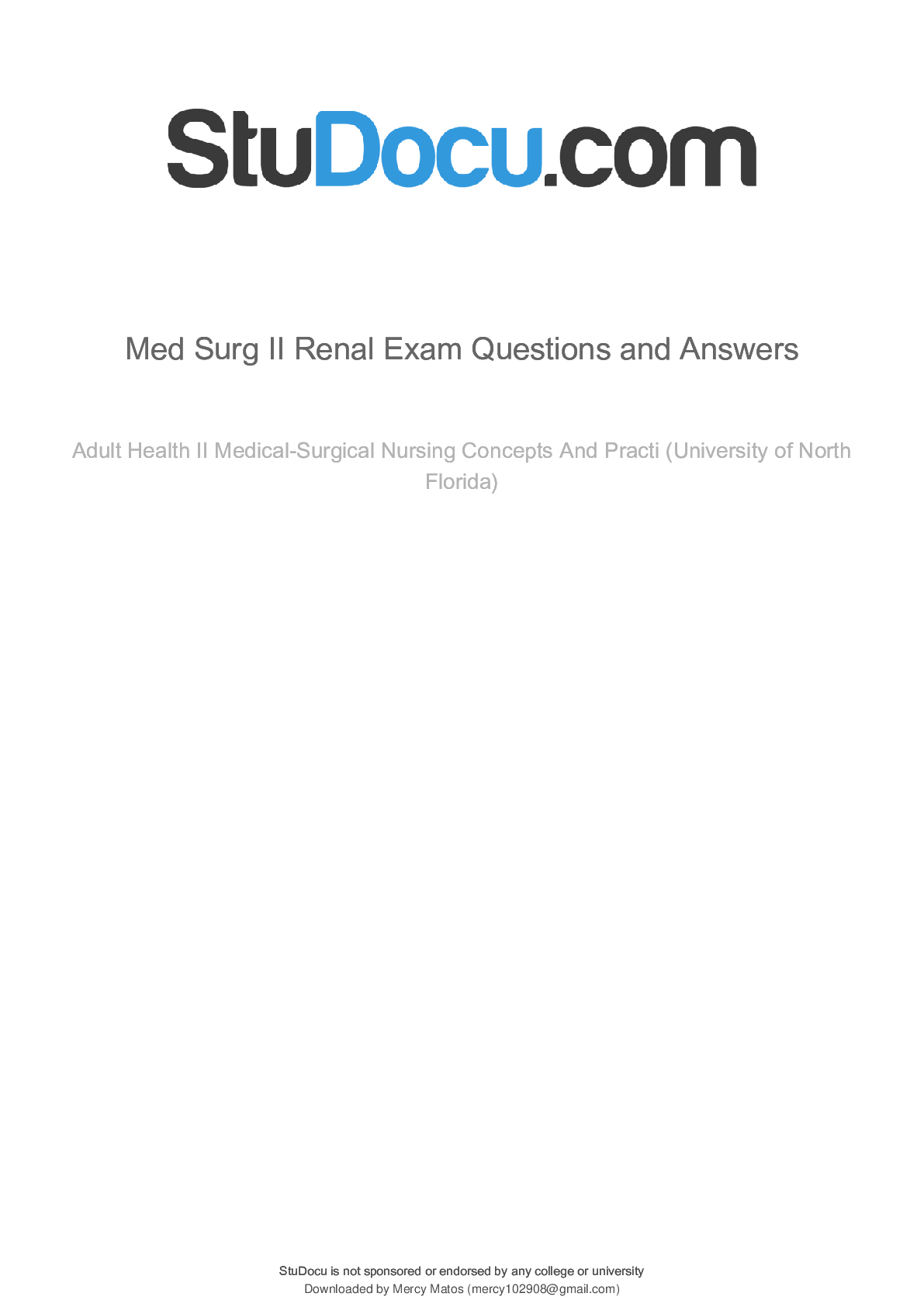
Reviews( 0 )
Document information
Connected school, study & course
About the document
Uploaded On
Jun 28, 2023
Number of pages
40
Written in
Additional information
This document has been written for:
Uploaded
Jun 28, 2023
Downloads
0
Views
136

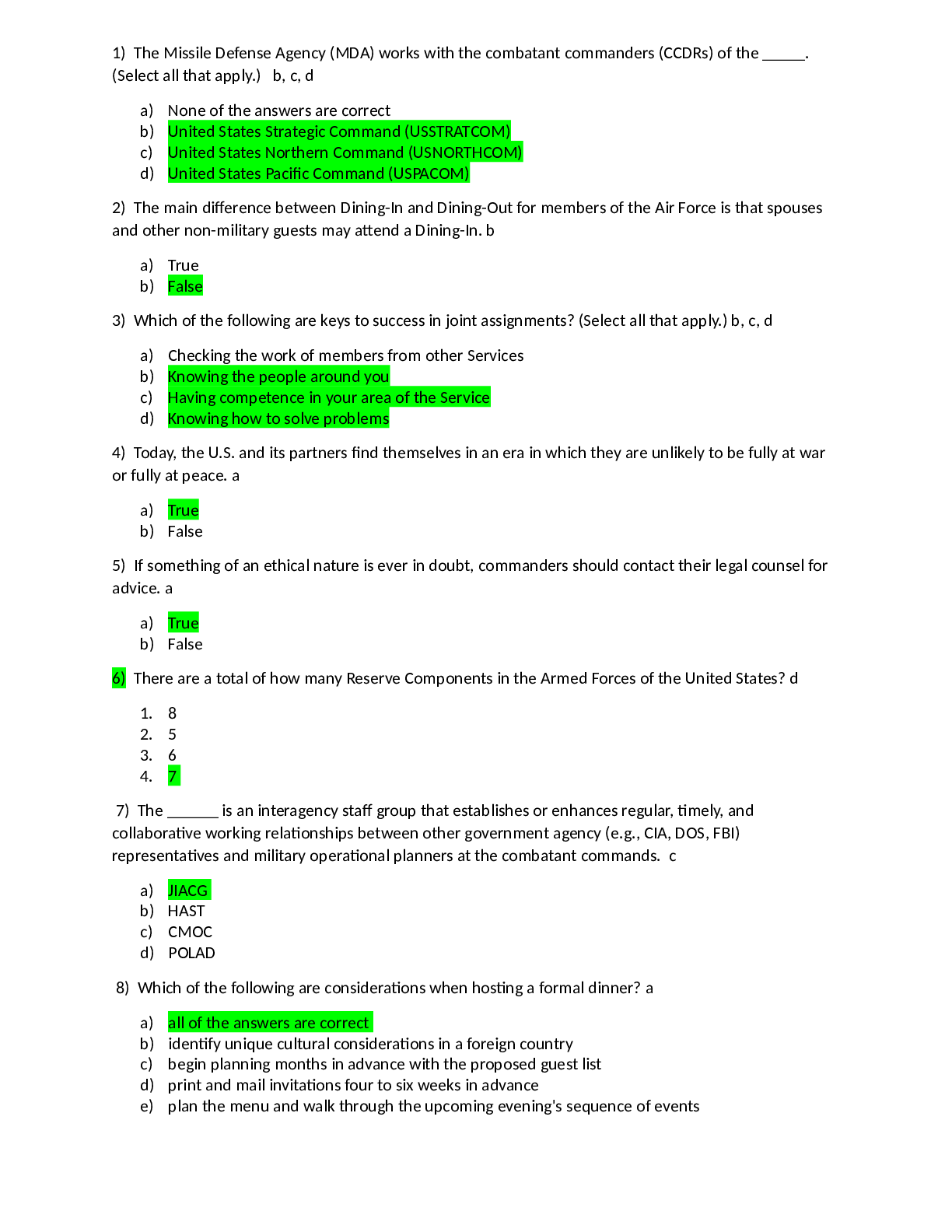
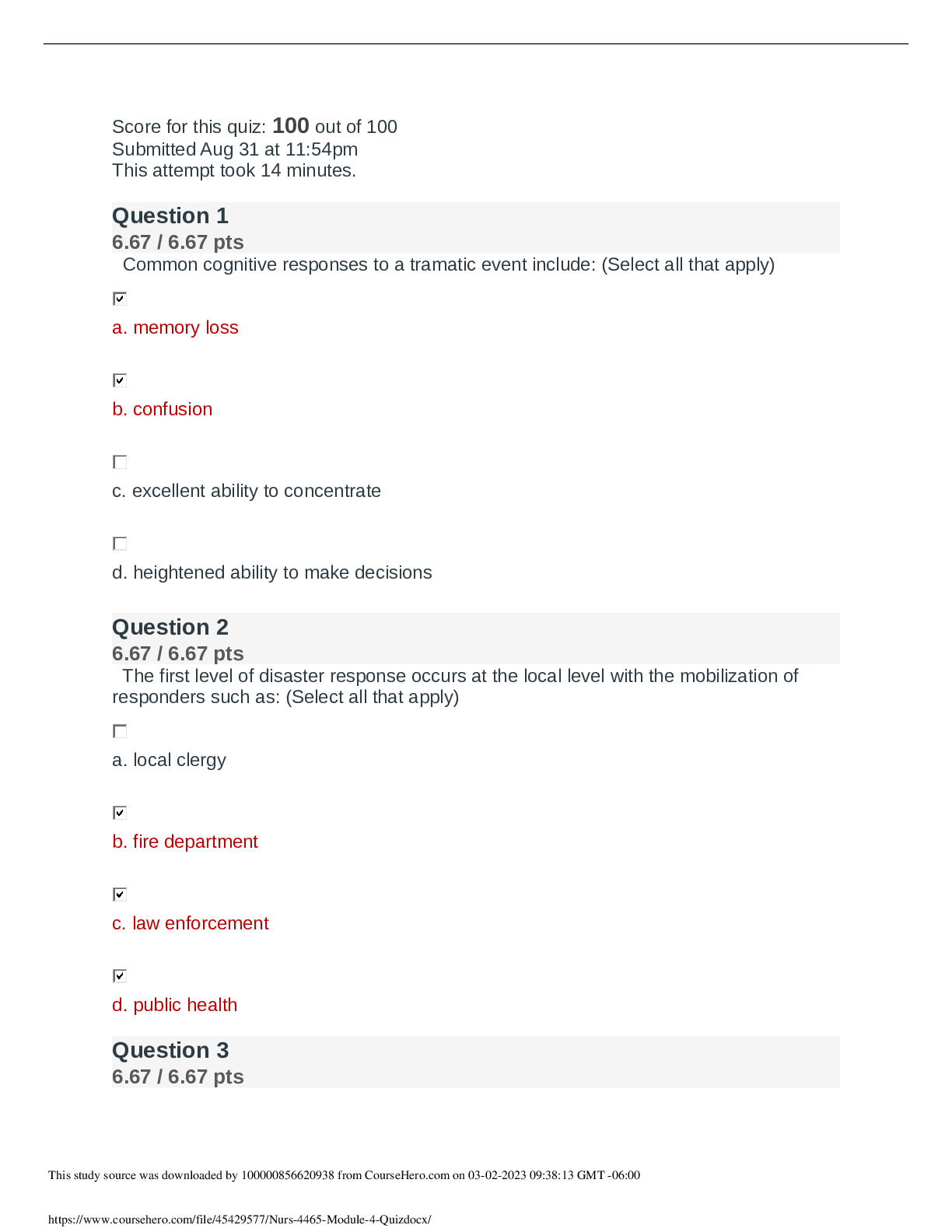
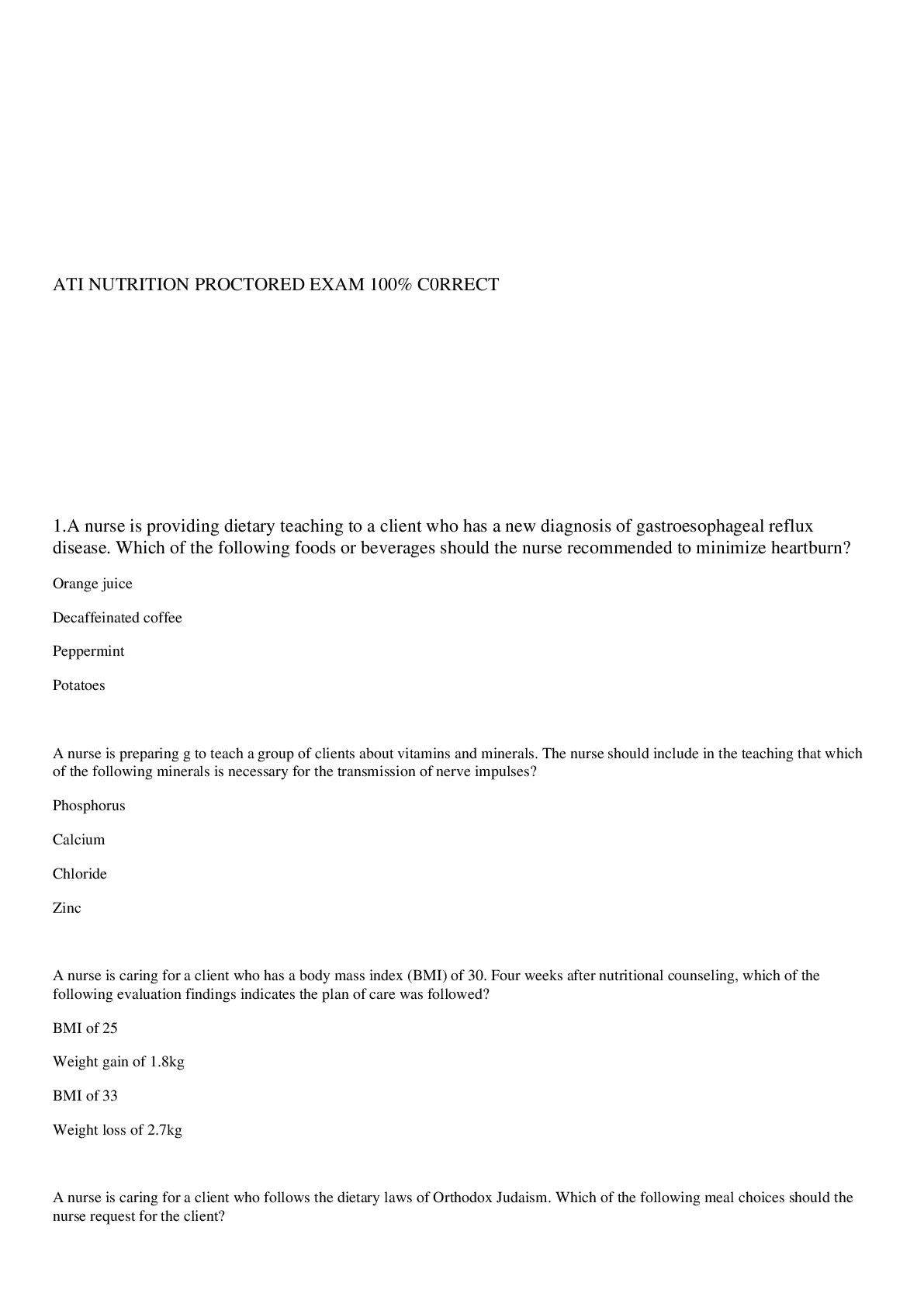
.png)
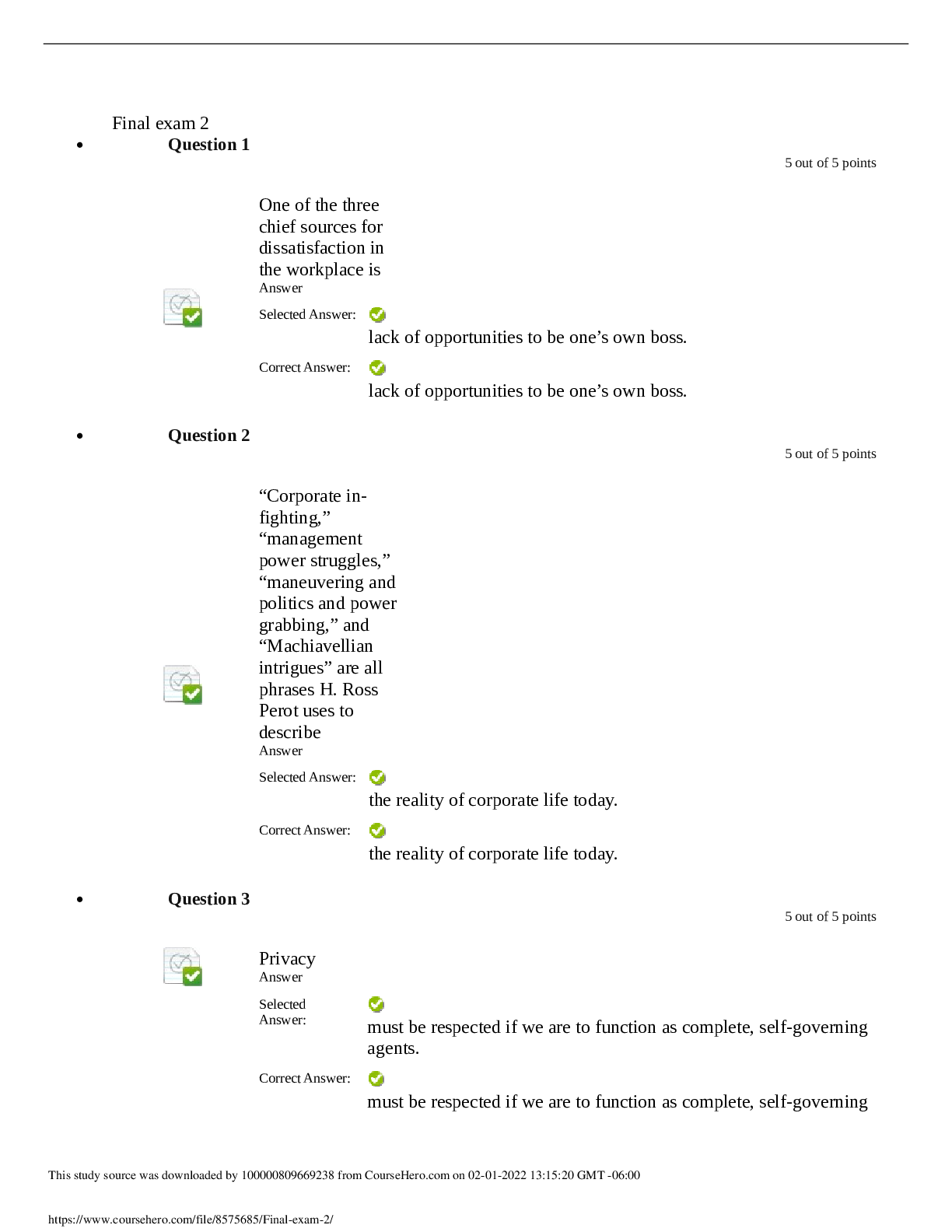
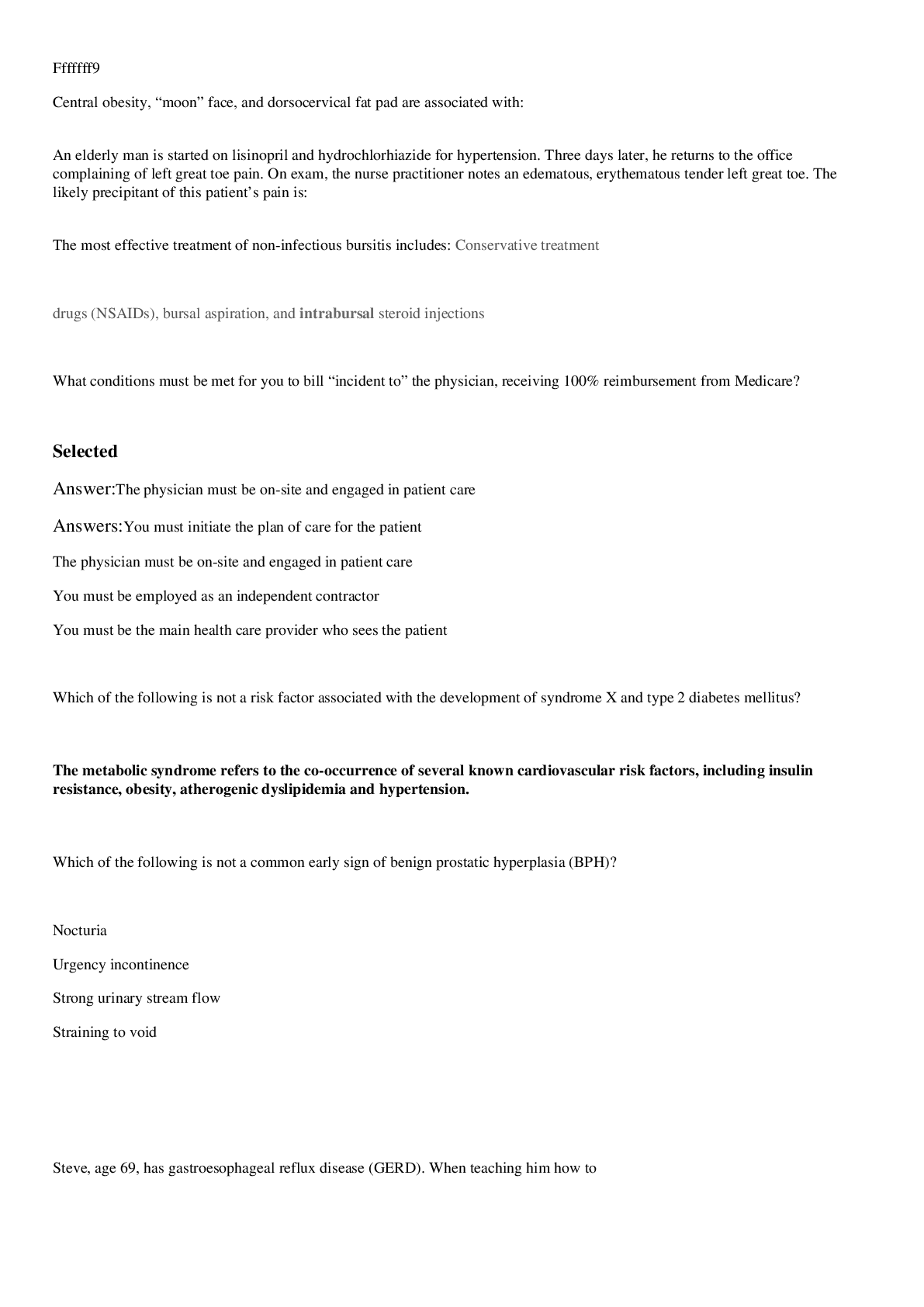
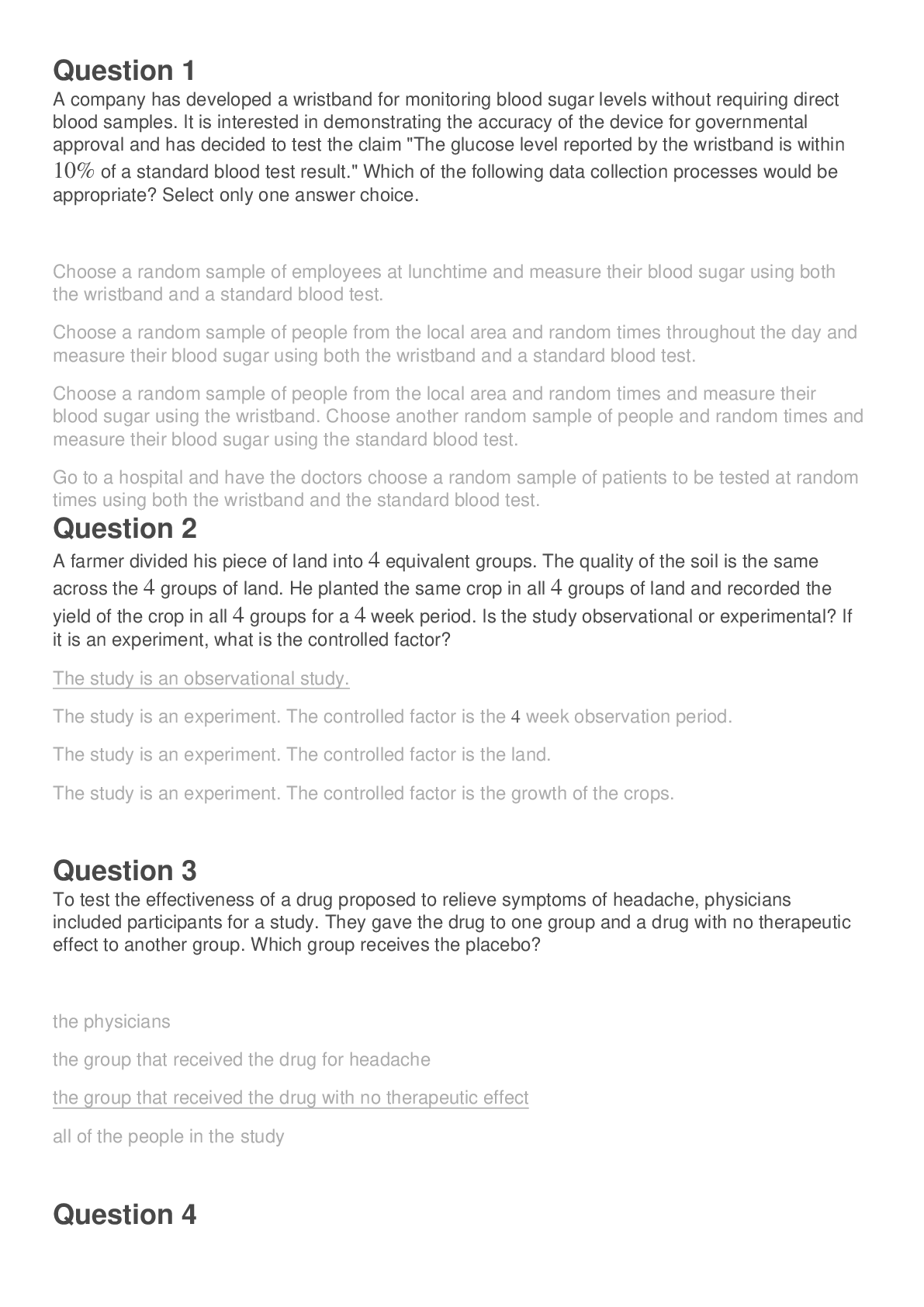
.png)
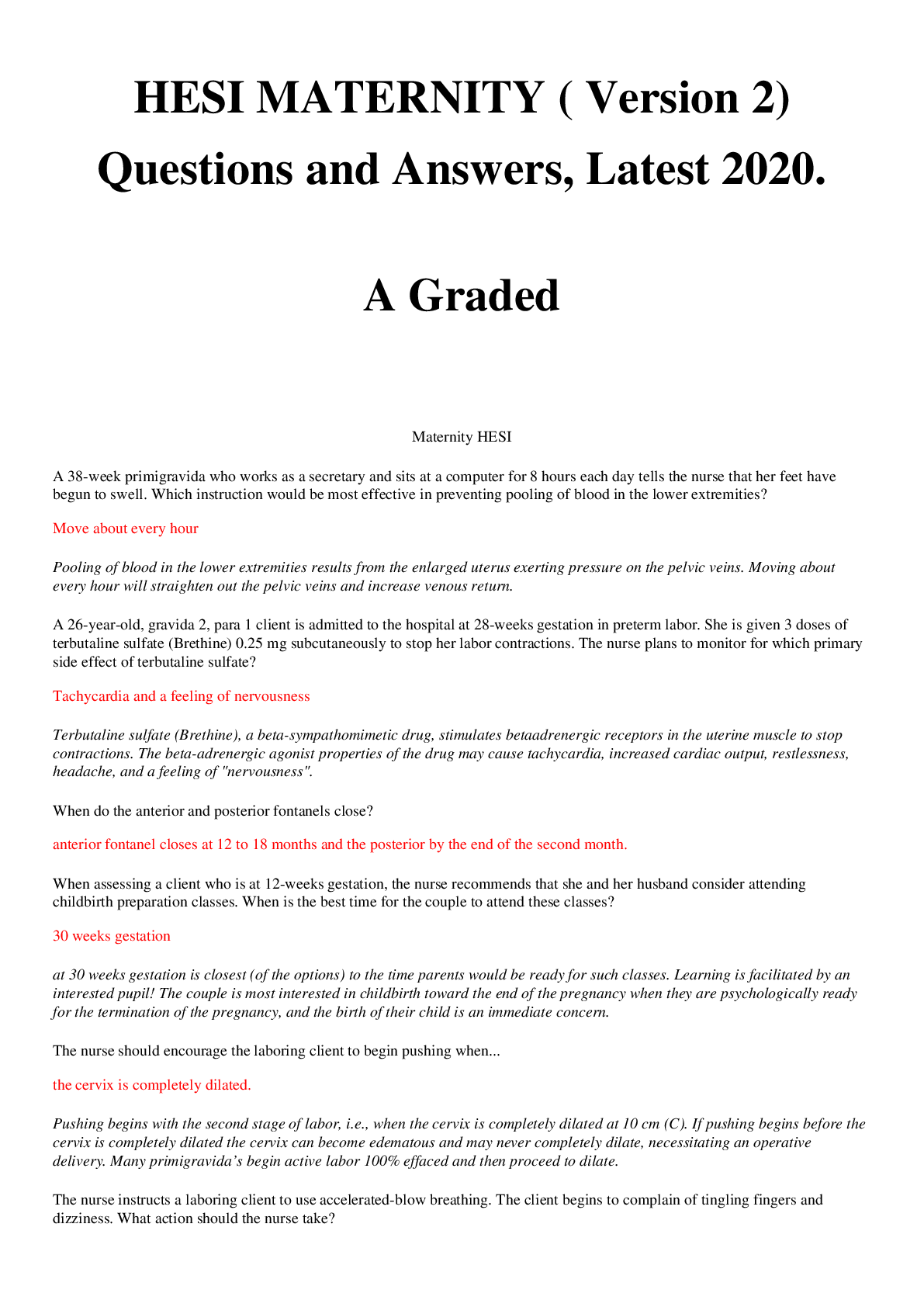
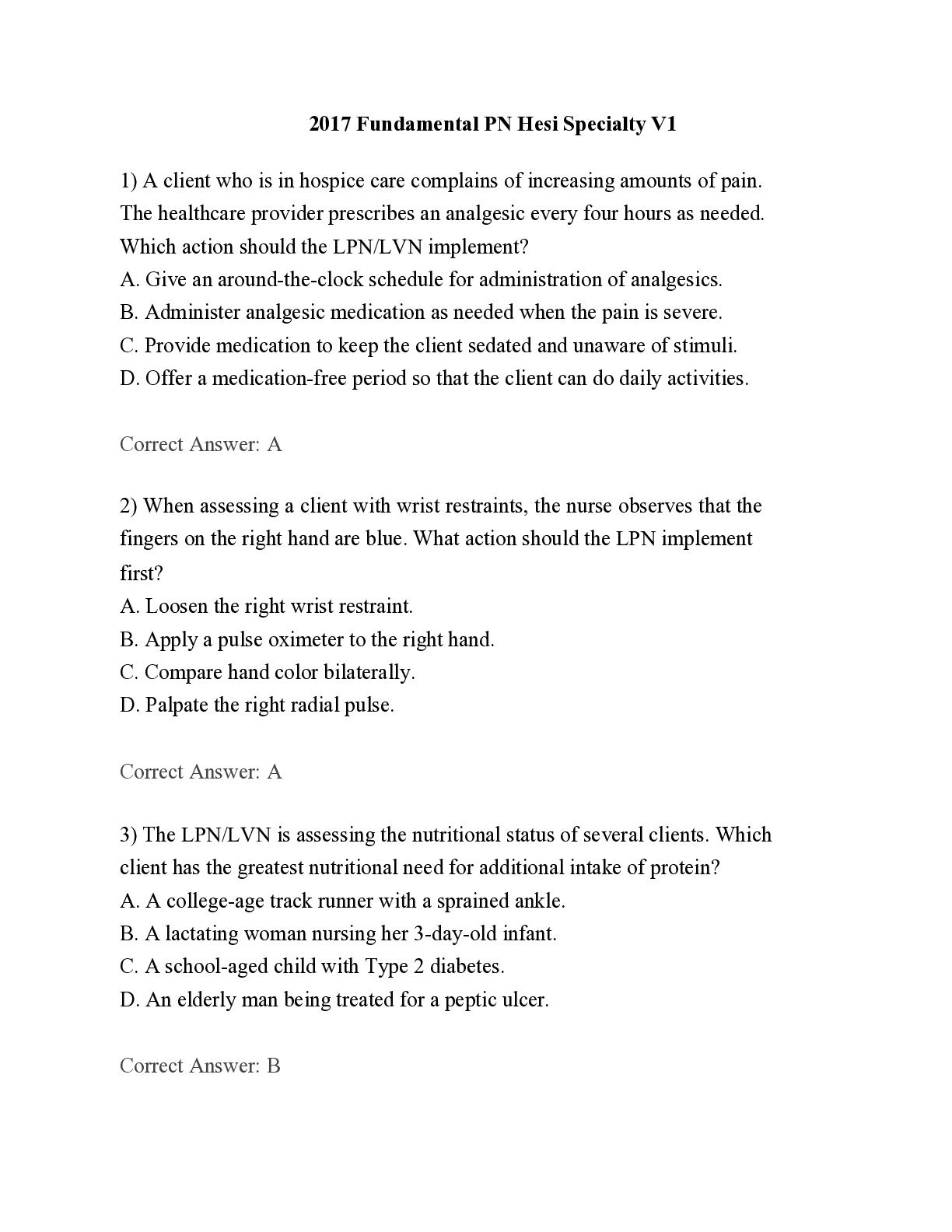
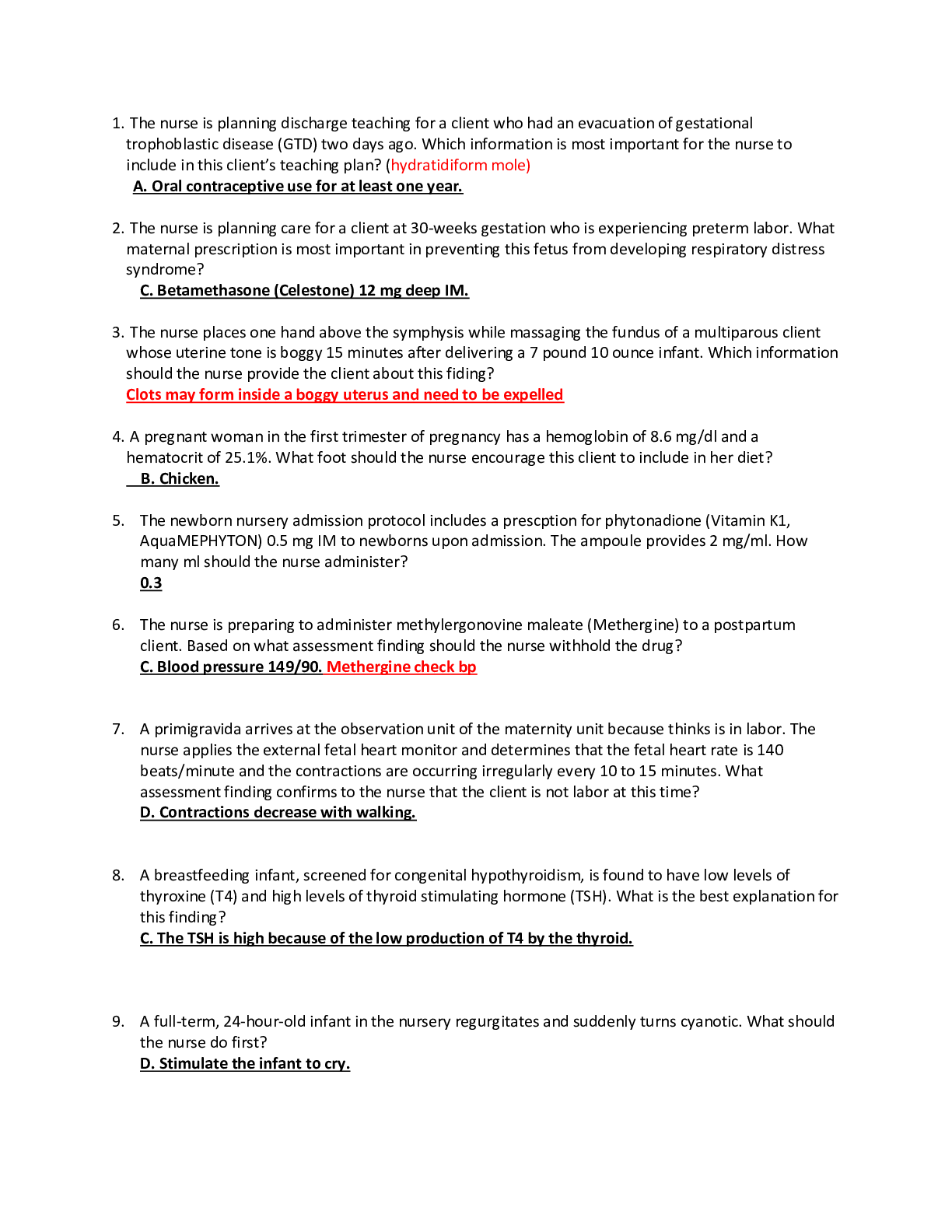
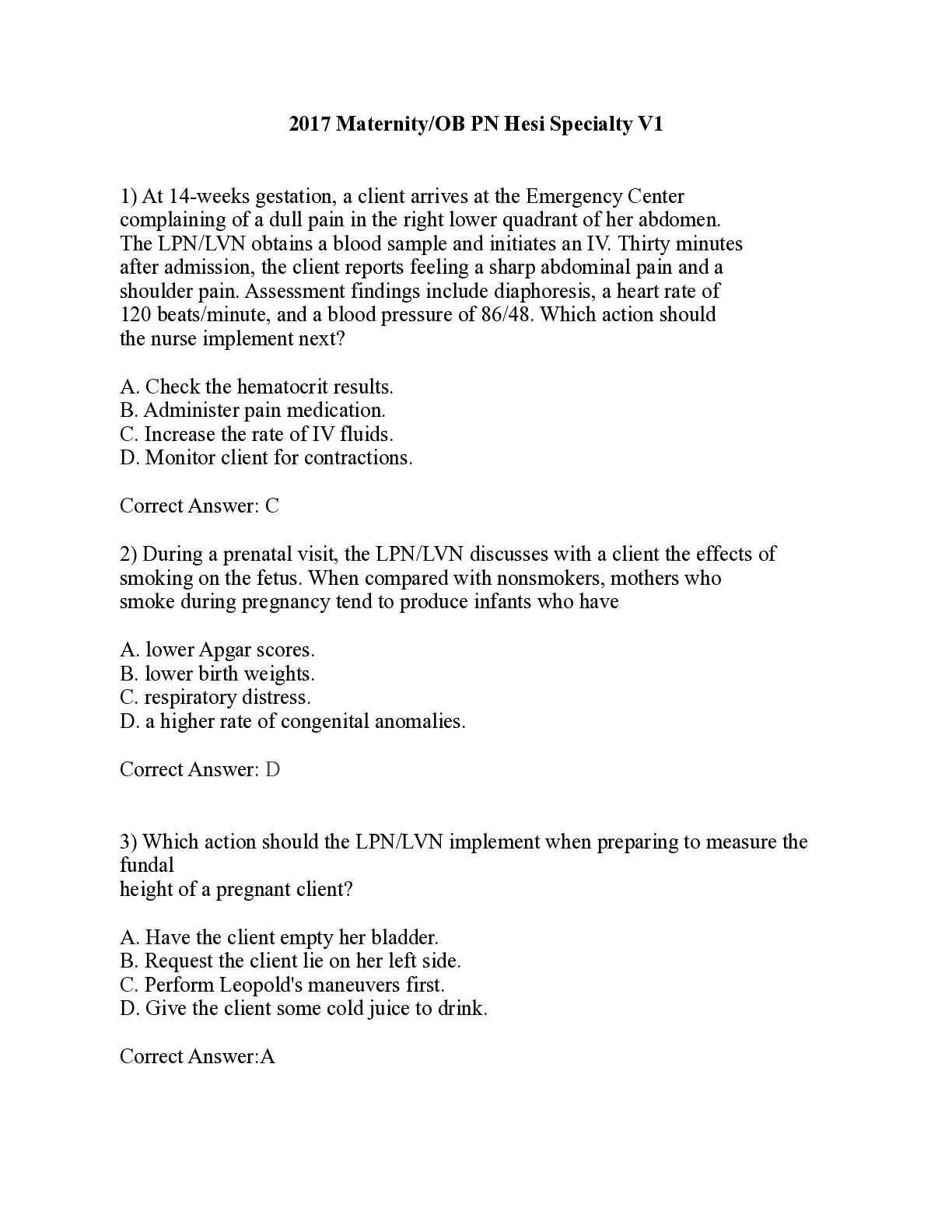
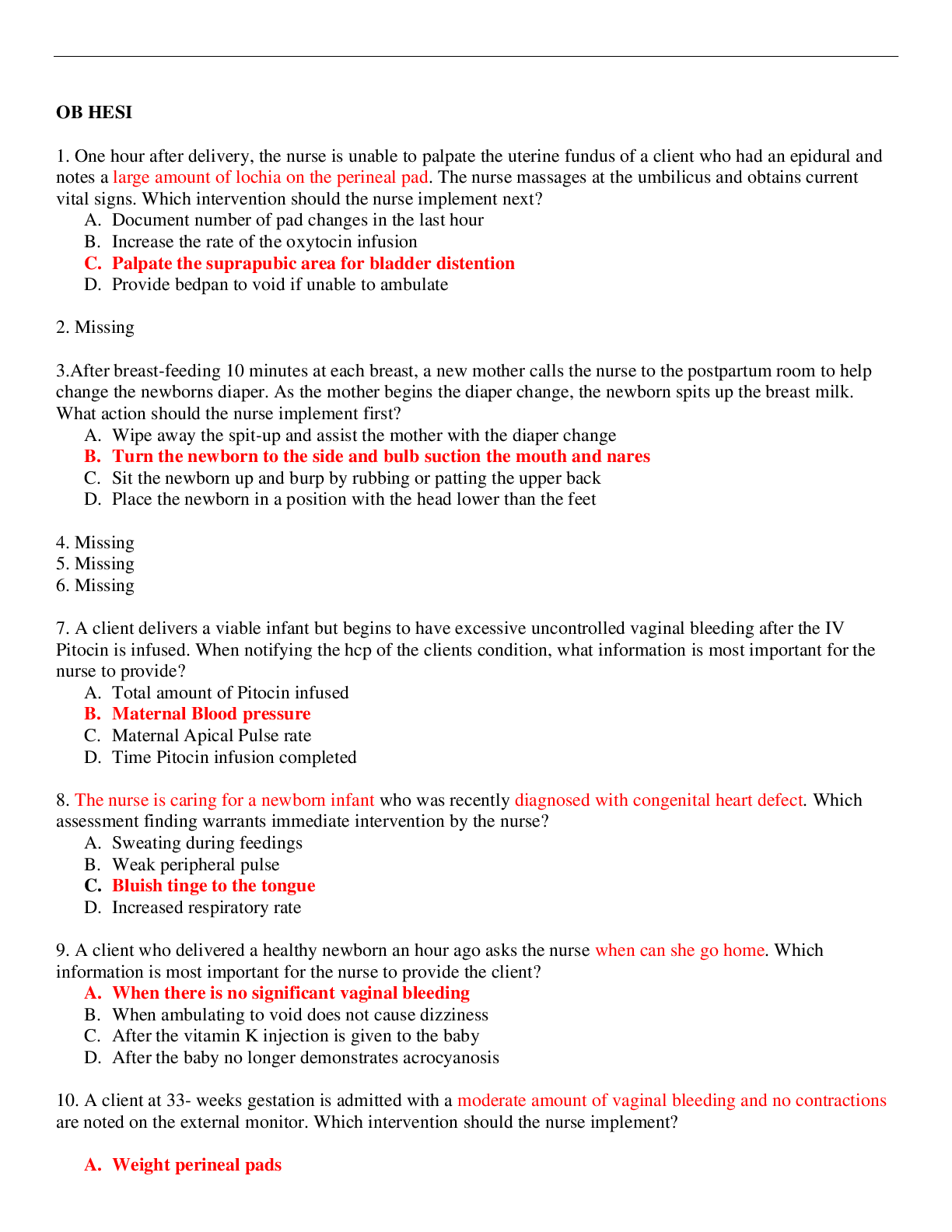
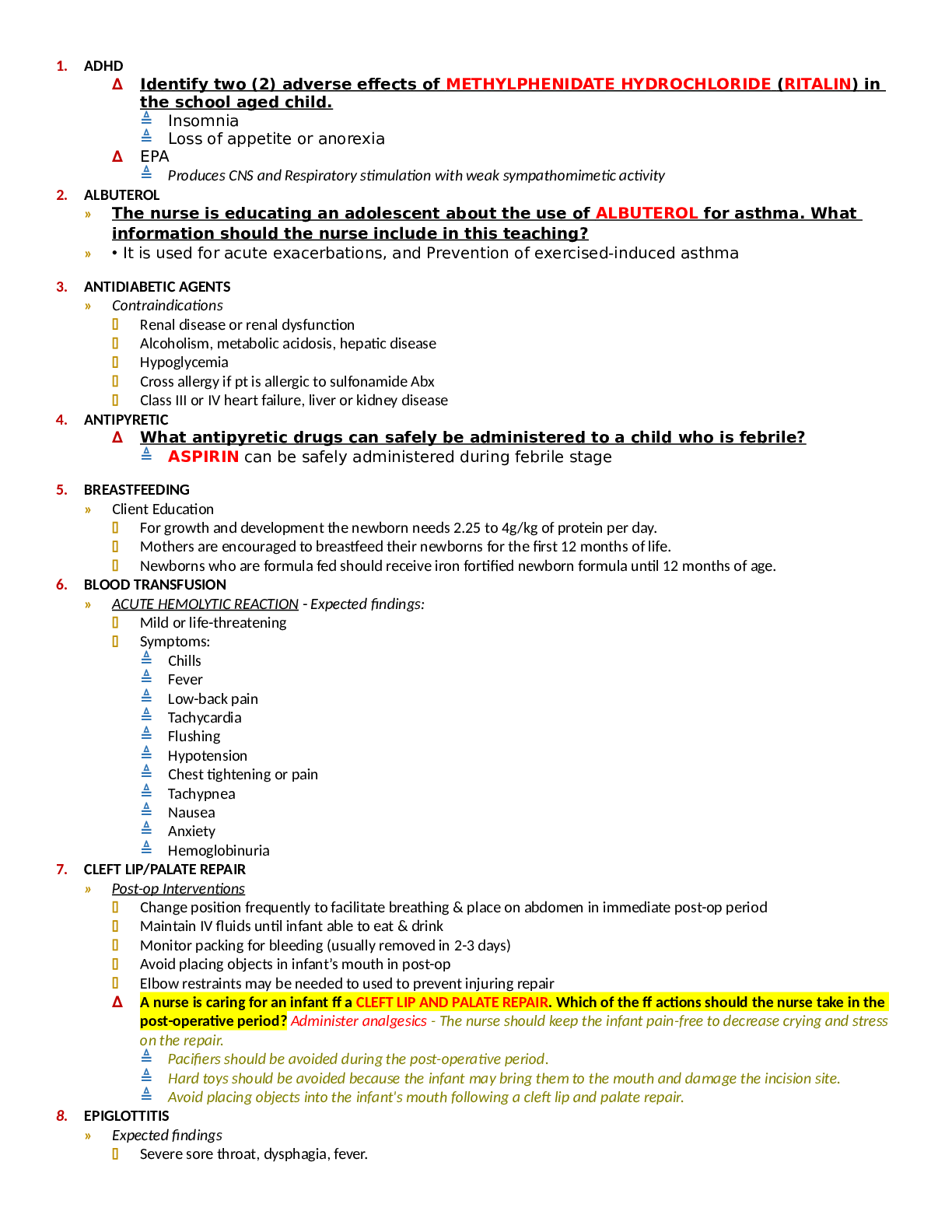
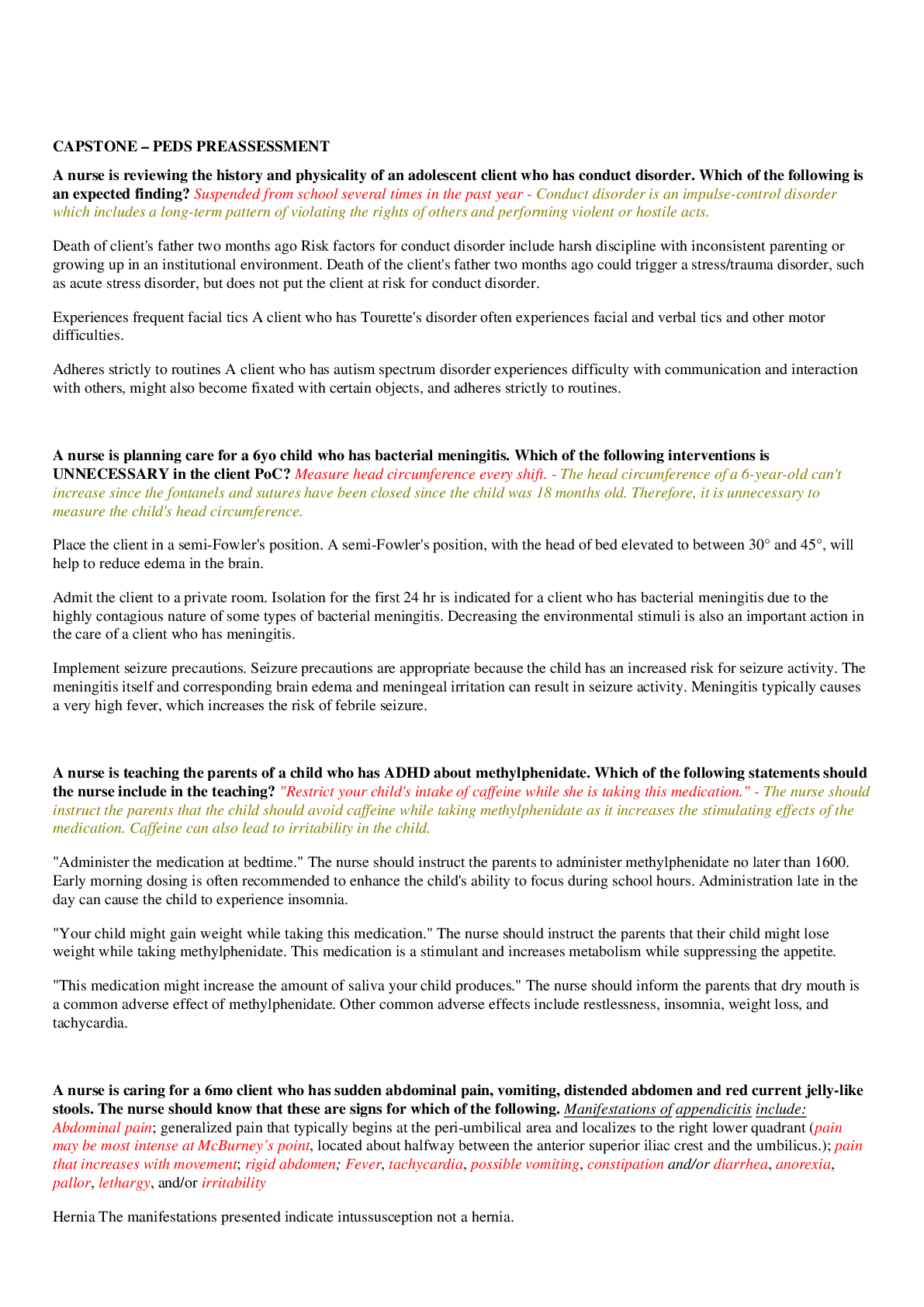

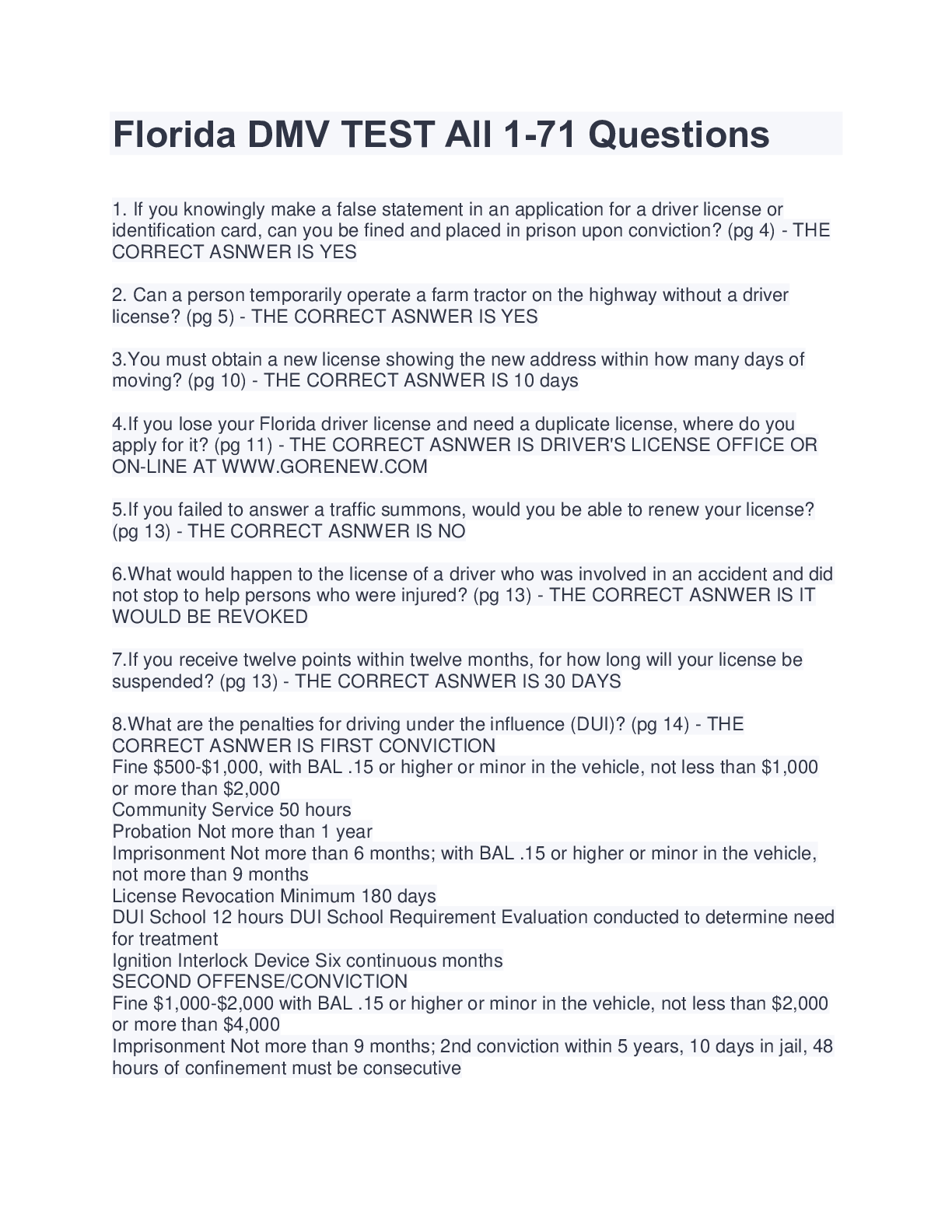
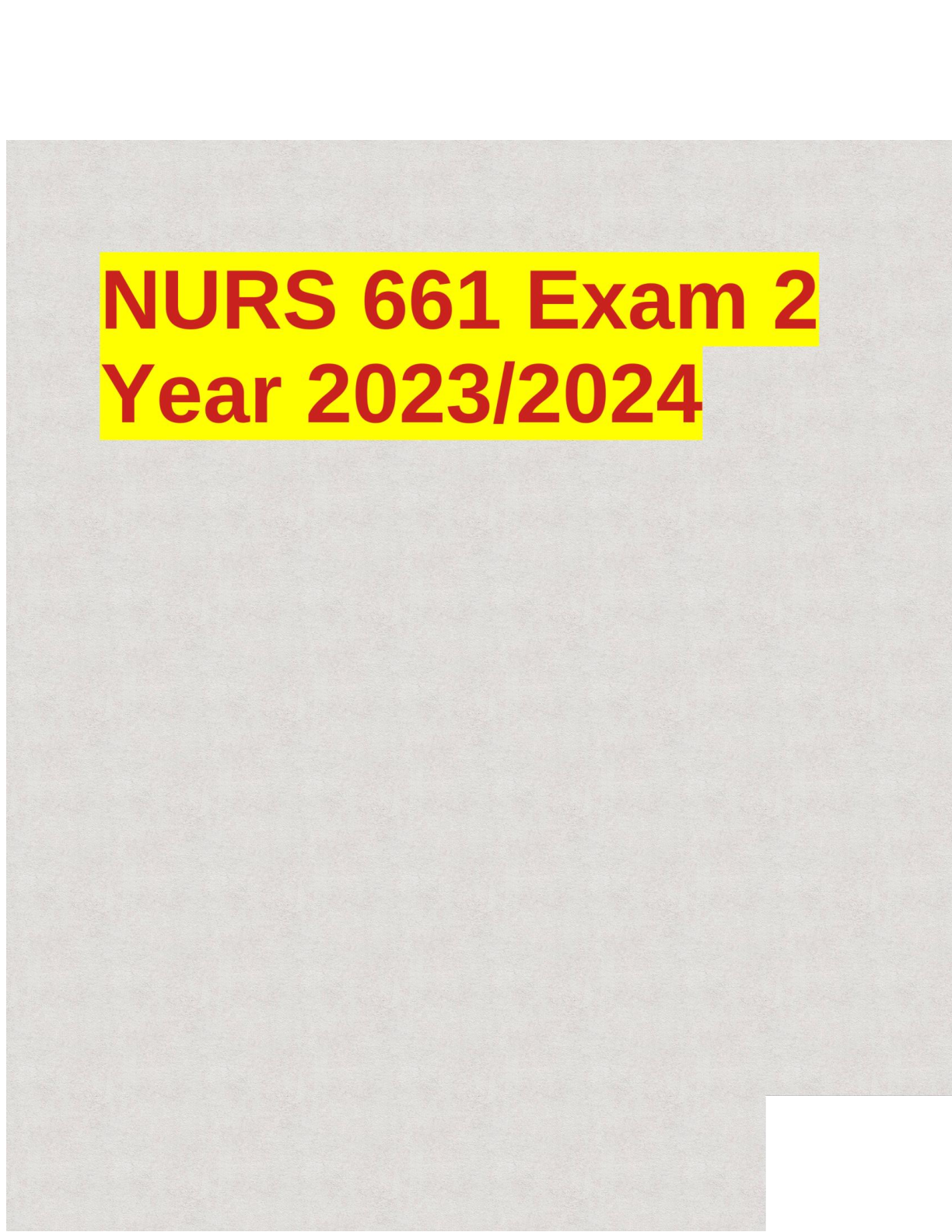

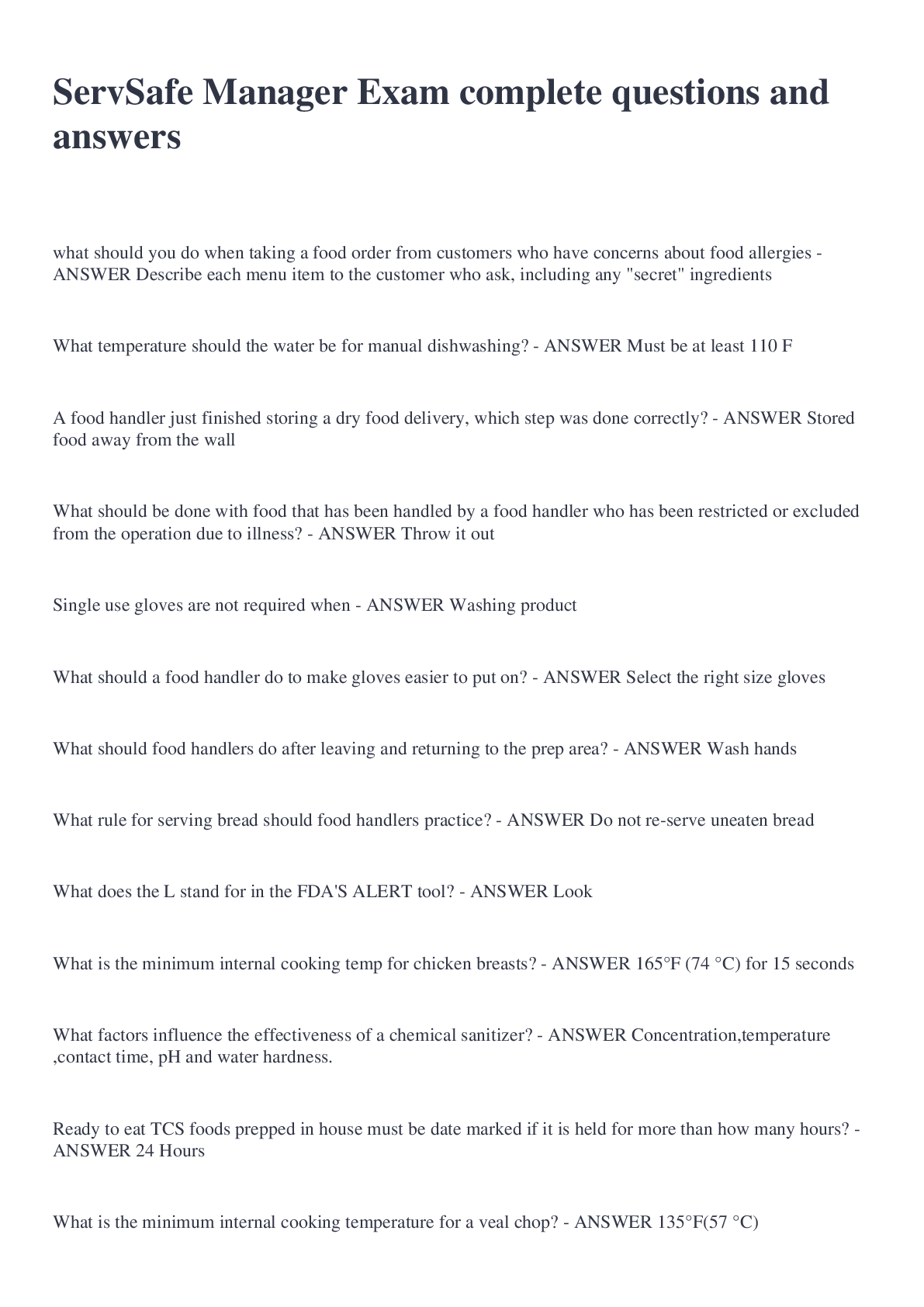


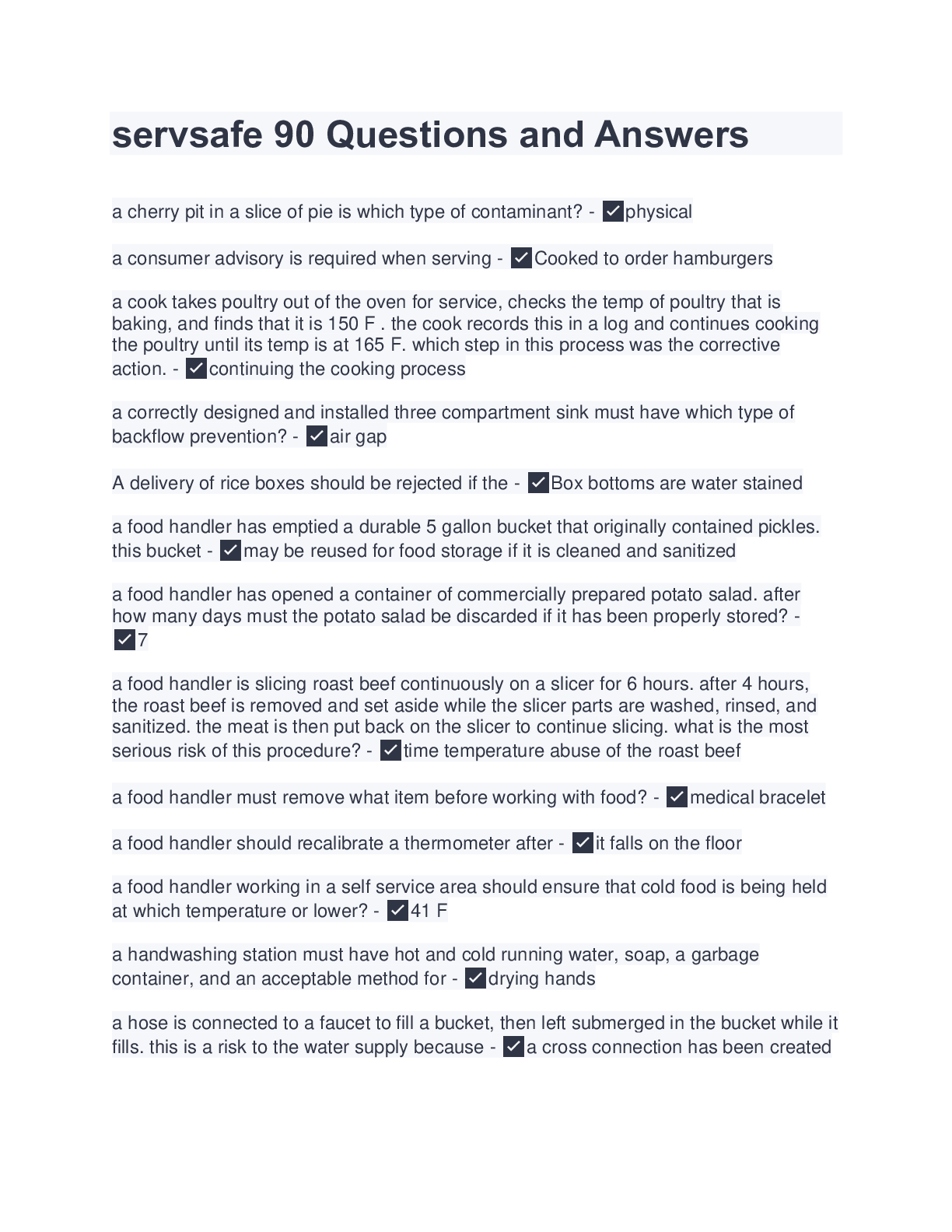
.png)


